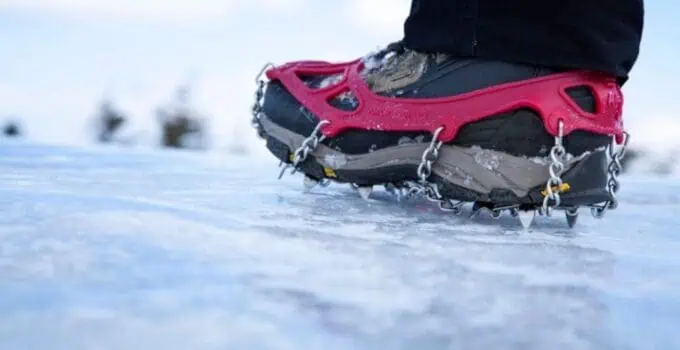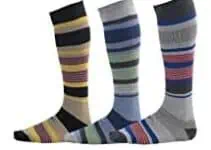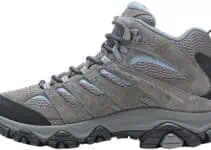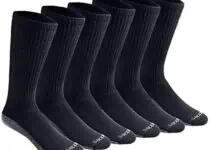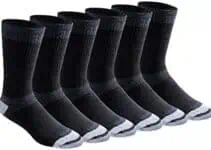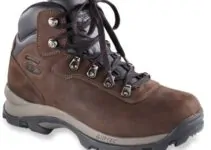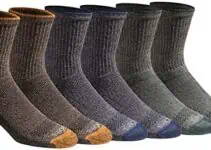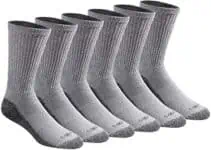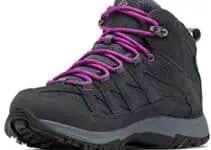Microspikes are an important tool for hiking in the winter. They give you extra grip on icy and snowy trails, helping you stay safe and steady. These small, easy-to-carry devices attach to your hiking boots. They have metal spikes that dig into the ice, making it easier to walk without slipping.
When you’re choosing the right microspikes for your boots, there are a few things to keep in mind:
- Spike Length: How long the spikes are can affect your grip.
- Harness Design: This is how the microspikes attach to your boots.
- Weight: You don’t want them to be too heavy to carry.
- Durability: You want spikes that will last, especially in tough conditions.
Choosing Between Microspikes and Crampons
The choice between microspikes and crampons depends on several factors:

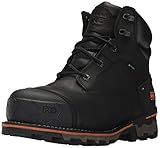






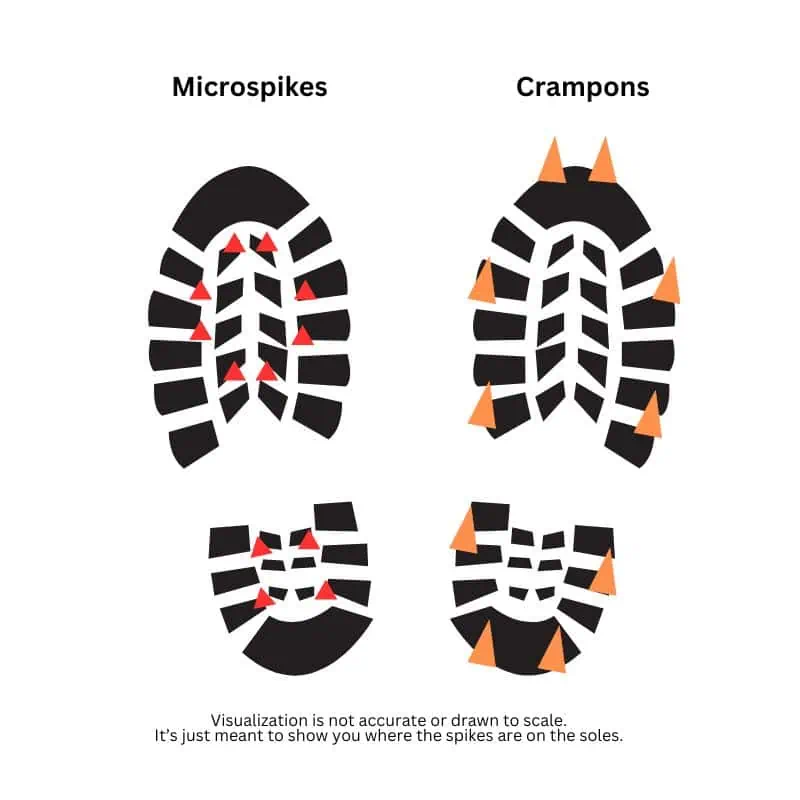
crampons vs microspikes
- Terrain: For moderate winter hiking on packed snow and light ice, microspikes are usually sufficient. For steep, icy slopes or glacier travel, crampons are necessary.
- Activity: Casual hikers and trail runners will find microspikes more suitable. Mountaineers and ice climbers should opt for crampons.
- Boot Compatibility: Crampons often require specific mountaineering boots, while microspikes fit a wide range of footwear.
- Weight Considerations: Microspikes are significantly lighter, making them preferable for long-distance hiking where every ounce counts.
- Skill Level: Crampons require more skill to use safely and are generally recommended for more experienced winter adventurers.
Top Picks for Microspikes
Here’s a breakdown of some of the best options out there:
Best Overall: Kahtoola MICROspikes

The Kahtoola MICROspikes are the top choice for most hikers. They come with 12 stainless steel spikes on each foot, which dig into icy surfaces really well. The harness fits securely over many different boot sizes, and they’re easy to put on, even with gloves.
Pros:
- Great grip on ice and packed snow
- Made from durable, high-quality materials
- Easy to put on and take off
- Lightweight and easy to pack
Cons:
- A bit pricey
- Overkill for light snow or city walking
These spikes work great in tough winter conditions, making them a favorite for serious hikers.
Best for Steep Terrain: Hillsound Trail Crampon Ultra

If you’re hiking on steep, icy slopes, the Hillsound Trail Crampon Ultra gives you extra grip. These spikes are a bit longer, with 18 stainless steel spikes on each foot. This gives you a strong hold on the ground, even when it’s really steep.
Pros:
- Excellent grip on steep and icy paths
- Strong and durable
- Comfortable fit
- Extra security with a velcro strap
Cons:
- Heavier than other options
- Too much for casual winter hikes
These are perfect for difficult trails, giving you the confidence to hike safely on steep slopes.
Best Lightweight Option: Black Diamond Distance Spike

If keeping your gear light is important, the Black Diamond Distance Spike is for you. With 14 spikes per foot, they still provide good grip while keeping weight low.
Pros:
- Super light at just 190 grams
- Compact, easy to store
- Good for moderate winter trails
- Comfortable and flexible fit
Cons:
- Not as strong as heavier spikes
- Not the best for very icy or steep hikes
These spikes are ideal for trail runners or anyone who needs to keep their gear light.
Best Budget Pick: Yaktrax Pro

For hikers who don’t want to spend a lot, Yaktrax Pro offers a budget-friendly option. Instead of spikes, they use coils to give you grip on packed snow and light ice.
Pros:
- Affordable
- Lightweight and easy to put on
- Works for many winter activities
- Good for mixed surfaces
Cons:
- Not as strong on ice
- May wear out faster
These are great for urban walks or occasional winter hikes. They won’t last as long as more expensive options but are good for light use.
Key Things to Consider When Buying Microspikes
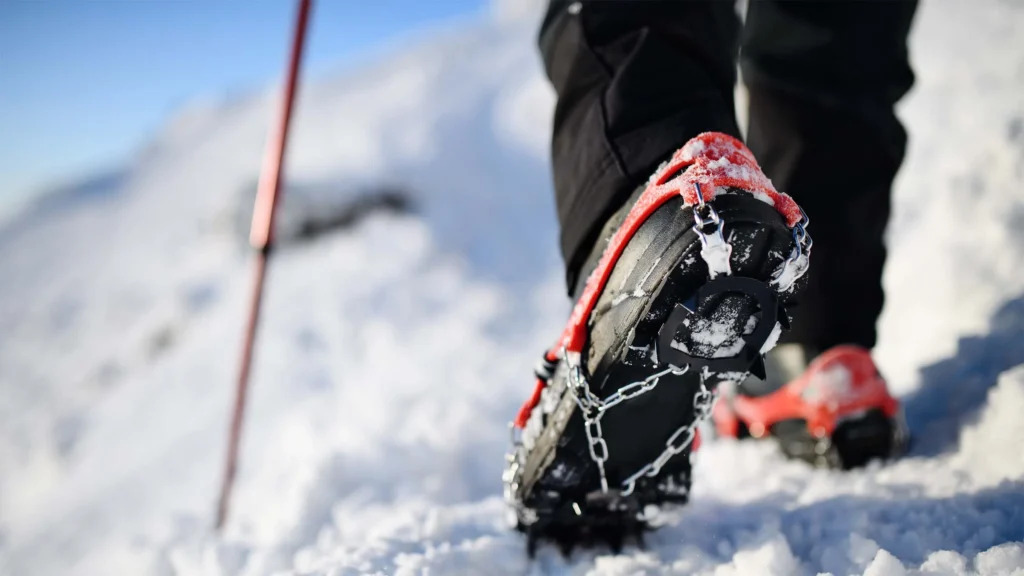
microspikes for hiking
When picking microspikes, think about:
- Spike Length: Longer spikes are better for ice, but shorter spikes might be more comfortable for mixed surfaces.
- Harness Design: Look for a harness that fits securely over your boots.
- Weight: Lighter spikes are easier to carry but may not last as long.
- Durability: High-quality spikes will last longer, especially in tough winter conditions.
- Terrain: The type of trails you hike on matters. If you’re facing steep, icy slopes, go for more aggressive spikes.
How to Use and Take Care of Your Microspikes
To get the most out of your microspikes, you need to use them right and take good care of them.
How to Put Them On:
- Stretch the harness over the toe of your boot.
- Pull it over the heel to secure it.
- Make sure the spikes are centered under your foot.
- To take them off, start at the heel and roll the harness forward.
Maintenance Tips:
- Rinse your microspikes after use to remove dirt and salt.
- Let them dry completely before storing them to prevent rust.
- Store them in a cool, dry place.
- Check them often for any wear and tear.
- If you’re not using them for a while, add a little silicone spray to the metal parts.
Stay Safe
- Always make sure your microspikes fit well before heading out.
- Don’t wear them indoors; they can damage floors.
- Remember that microspikes help with traction, but they don’t replace safe hiking skills.
- If you’re going on a long hike, bring a backup pair, just in case.
Final Thoughts
Choosing the right microspikes can make your winter hikes much safer and more enjoyable. Here’s a quick recap:
- Kahtoola MICROspikes are the best all-around choice.
- Hillsound Trail Crampon Ultra is great for steep hikes.
- Black Diamond Distance Spike is perfect for those who need a lightweight option.
- Yaktrax Pro is the best budget-friendly choice.
Pick the microspikes that match your hiking style and the conditions you’ll face most often. Take care of them, and they’ll take care of you on your winter adventures.

